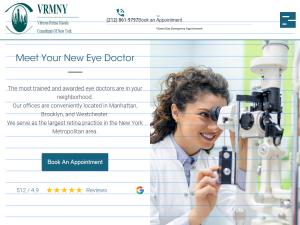Macular degeneration treatment in New York
950 3rd Ave 3rd floor
New York, NY 10022
An ophthalmologist can identify macular degeneration or determine if you are at risk for developing the disease. Your exam will begin with a test to measure the sharpness of your vision. The most common visual acuity test features lines of black letters on a white chart. Next, your doctor will determine if you have areas of reduced or distorted vision using an Amsler grid. Reduced and distorted vision are common symptoms of macular degeneration.
After these tests, the ophthalmologist will evaluate the front of your eyes and measure eye pressure. Next, your retina will be examined using a special microscope known as a slit lamp. Your pupils will need to be dilated for a thorough exam. Using the slit lamp, the ophthalmologist can check for drusen, atrophic areas, pigmentation, and identify any other retinal abnormalities.
Early choroidal neovascularization is typically not visible, but the ophthalmologist can look for symptoms that indicate it, including bleeding or fluid behind or within the retina. In this case, more testing is needed.
VABYSMO (Faricimab-Svoa)
Vabysmo was approved by the FDA in 2022. When compared with Eylea, it appeared to last longer, while providing the same vision gains. Side effects appear to be similar to Lucentis and Eylea.
Macugen
Macugen was the first drug approved to treat wet AMD. Macugen appears to be much less effective than the other anti-VEGF medications and is therefore only rarely used nowadays.
Lucentis
Lucentis was the second drug to be approved by the FDA for the treatment of wet AMD. Its effect is more powerful than Macugens. On average, 21 letters on a specialized reading chart (ETDRS chart) were gained, and about 40 percent of patients regained the ability to read newspaper print (20/40). Not all patients did improve their vision, but 90 percent resulted better or stable vision.
These results of the wet macular degeneration treatment using Lucentis represented a breakthrough compared to the natural history of the disease, which essentially leads to legal blindness in the vast majority of patients.
Vitreous Retina Macula Consultants of New York
950 3rd Ave 3rd floor,
New York, NY 10022
(212) 861-9797
Fax: (212) 628-0698
Web address:
https://www.vrmny.com/conditions/age-related-macular-degeneration/
Our location on map:
https://goo.gl/maps/v9rE1BWBd6tsFgPaA
https://plus.codes/87G8Q26J+3R New York
Nearby Locations:
Manhattan, NY
Lenox Hill | Upper East Side | Midtown East | Upper West Side
10021 | 10022 | 10023
Working Hours:
Monday-Friday: 8am - 5pm
Payment: cash, check, credit cards.
Keywords: ophthalmology, ophthalmology practice, eye surgery center, eye surgical center, new york eye surgery center, eye care surgery center, retina eye center, retina center, retina eye surgery practice, retina surgery center, retina vitreous center, retina eye clinic, retina specialists NYC, retina doctors NYC, retina specialist, retina specialists, ophthalmologist, ophthalmologists, eye doctor, eye doctors, retina surgeon, retina surgeons, retina doctor, retina doctors, eye surgery doctor, retina vitreous surgeon, retina vitreous specialists, macular degeneration treatment, diabetic retinopathy treatment, macular hole surgery, retinal detachment surgery, vitrectomy surgery
Be the first to review Macular degeneration treatment in New York - Use the thumbs to get started!
- ©2025 newyorkcountybizlist.com
- Privacy Policy
- FAQ
- Contact
This site has been visited 17,792 times






.jpg&newheight=30&newwidth=30)


